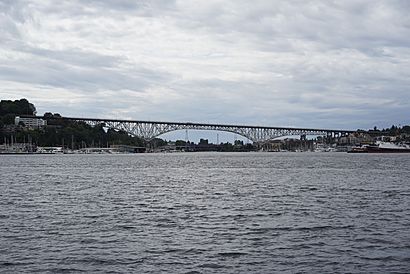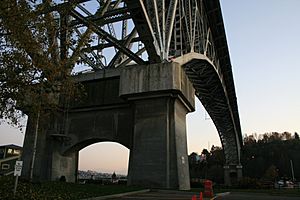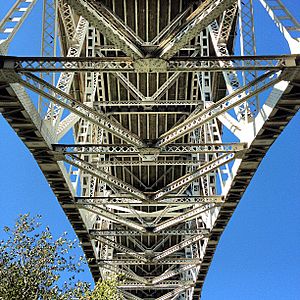Aurora Bridge facts for kids
Quick facts for kids Aurora Bridge |
|
|---|---|

The main span of the bridge in 2015, looking west. The suspended truss is visible at the center of the cantilever arch structures
|
|
| Carries | |
| Crosses | Lake Union |
| Locale | Seattle, Washington, U.S. |
| Official name | George Washington Memorial Bridge |
| Maintained by | Washington State DOT |
| ID number | 0001447A0000000 |
| Characteristics | |
| Design | Mixed, cantilever and truss |
| Total length | 2,945 ft (898 m) |
| Width | 70 ft (21 m) |
| Longest span | 475 ft (145 m) |
| Clearance below | 167 ft (51 m) |
| History | |
| Opened | February 22, 1932 |
| Statistics | |
| Daily traffic | 61,998 (2017) |
|
Aurora Avenue Bridge
|
|
| Location | Aurora Ave., N. over Lake Washington Ship Canal, Seattle, Washington |
| Built | 1931–32 |
| Built by | U.S. Steel Products Corp. |
| Architect | Jacobs & Ober |
| MPS | Historic Bridges/Tunnels in Washington State TR |
| NRHP reference No. | 82004230 |
| Added to NRHP | July 16, 1982 |
The Aurora Bridge, officially known as the George Washington Memorial Bridge, is a famous bridge in Seattle, Washington. It's a special type of bridge called a cantilever and truss bridge. It carries State Route 99 (also known as Aurora Avenue North) over the western part of Seattle's Lake Union. This bridge helps connect the neighborhoods of Queen Anne and Fremont.
The Aurora Bridge is owned and managed by the Washington State Department of Transportation. It is about 2,945 feet (898 meters) long and 70 feet (21 meters) wide. It stands 167 feet (51 meters) above the water. The bridge first opened to traffic on February 22, 1932. This date was chosen because it was the 200th birthday of George Washington, who the bridge is named after. In 1982, the bridge was added to the National Register of Historic Places, which means it's an important historical site.
Contents
How the Bridge Was Built
The Aurora Bridge is very long, stretching almost 3,000 feet. It is also 70 feet wide and stands 167 feet above the water. The Washington State Department of Transportation (WSDOT) takes care of it.
The bridge has two large V-shaped sections that support the road. Each of these sections is 325 feet long. They are balanced on huge concrete foundations on both sides of the ship canal. These foundations act as the main supports. To make these foundations strong, many timber piles were driven deep into the ground. About 828 piles were used for the south side and 684 for the north side. These piles are very long, reaching 50 to 55 feet below the water's surface. Together, these foundations can hold up a massive weight of 8,000 tons. Building them needed a special machine called a pile driver that could work underwater.
In the middle, a 150-foot-long Warren truss section connects the two main V-shaped parts. This middle section is the bridge's main span, measuring 475 feet long. At both ends of the bridge, there are more Warren truss sections. These connect the main bridge parts to the highway.
A Look Back: Bridge History
Work on the bridge's supports started in 1929. The main bridge construction began soon after in 1931. The bridge was officially opened on February 22, 1932. This was George Washington's 200th birthday. A time capsule was placed on the bridge by Judge Thomas Burke's widow. It is set to be opened in 2032.
The Aurora Bridge was the last piece of a major road called the Pacific Highway. This highway used to run all the way from Canada to Mexico. The bridge crosses the Lake Union part of the Lake Washington Ship Canal. Unlike older bridges in the area, the Aurora Bridge was built high enough that it didn't need a drawbridge to let boats pass. In 1930, the Seattle City Council decided to build parts of the highway through the Woodland Park Zoo. This decision caused a lot of discussion at the time.
The Seattle architectural firm Jacobs & Ober designed the bridge. Ralph Ober was the lead engineer. Sadly, Ober passed away in August 1931 from a serious illness while the bridge was still being built. At that time, there were no federal funding programs for bridges. So, Seattle, King County, and the state of Washington paid for the bridge.
The bridge was suggested for the National Register of Historic Places in 1980. It was recognized for its useful and beautiful design. It was also the first bridge in the area built without tracks for streetcars. It was officially added to the National Register on July 16, 1982.
The Fremont Troll and Bridge Safety
In 1990, a large cement sculpture called the Fremont Troll was placed under the bridge's north end. This troll sculpture is holding a real Volkswagen Beetle car. About half of the $40,000 cost for this artwork came from Seattle's Neighborhood Matching Fund. This fund helps local groups raise money for community projects. After it was built, the Troll was damaged by vandals. To stop more damage, bright floodlights were put on the bridge.
After a bridge accident in another state in 2007, the WSDOT checked all steel cantilever bridges in Washington. This included the George Washington Memorial Bridge. The bridge had already been checked and found to be strong. That same year, a national bridge survey found the bridge to be "functionally obsolete." This means it still works but doesn't meet all modern standards. However, its foundations and railings were good, and no immediate fixes were needed.
The George Washington Memorial Bridge got major upgrades in 2011 and 2012. These upgrades, costing $5.7 million, made the bridge safer in case of an earthquake. In October 2019, engineers found that a beam on the southbound side of the bridge had rusted. This caused a small dip in the road. Traffic was reduced to two lanes for an emergency repair. The repair cost $500,000 and took seven days to complete.
Images for kids
-
One of six emergency phones on the bridge





